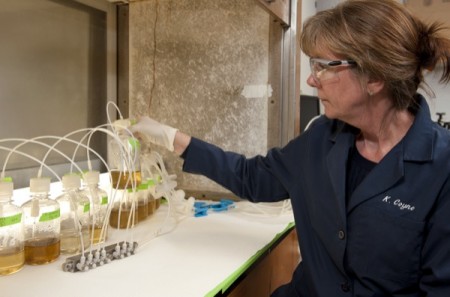Jun
28
Can An Algae Save Coal Power Generation?
June 28, 2013 | 7 Comments
The microscopic algae Heterosigma akashiwo grows rapidly on a gas mixture that has the same carbon dioxide and nitric oxide content as emissions released from a power plant.

Dr. Kathryn Coyne does research with H. Akashiwo Algae in her lab in Cannon Hall in Lewes. Click image for the largest view.
Coyne, an associate professor of marine biosciences in UD’s College of Earth, Ocean, and Environment said, “The algae thrive on the gas. They grow twice as fast and the cells are much larger in size compared to when growing without gas treatment.”
The algae also make large amounts of carbohydrates, which can be converted into bioethanol to fuel vehicles. The findings could have industrial applications as a cost-effective way to cut greenhouse gas pollution when paired with biofuel production.
Heterosigma akashiwo is found worldwide in the natural environment. Coyne, an expert in algal blooms, discovered that the species might have a special ability to neutralize nitric oxide – a harmful gas that poses threats to environmental and human health.
That characteristic prompted Coyne and her team to investigate whether the algae could grow on carbon dioxide without getting killed off by the high nitric oxide content in power plants’ flue gas, which had foiled similar attempts by other scientists using different types of algae.
A yearlong laboratory experiment shows that Heterosigma akashiwo not only tolerates flue gas, but flourishes in its presence. The algae also do not need any additional nitrogen sources beyond nitric oxide to grow, which could reduce costs for raising algae for biofuel production.
“This alone could save up to 45 percent of the required energy input to grow algae for biofuels,” Coyne said.
Funded by the Delaware Sea Grant College Program, Coyne and her collaborator, Jennifer Stewart, plan to further study how changes in conditions can enhance the growth of Heterosigma akashiwo. So far, they found a large increase in carbohydrates when grown on flue gas compared to air. They also see correlations between the levels of light given to the algae and the quantity of carbohydrates and lipids present in the organisms.
The researchers are exploring opportunities for partnerships with companies to scale up the growth process and more closely examine Heterosigma akashiwo as a biofuel producer.
The prospects could support a national focus on carbon pollution reduction following President Barack Obama’s major speech this week on climate change.
“Our approach to the issue is to not just produce biofuels, but to also use this species for bioremediation of industrial flue gas to reduce harmful effects even further,” Coyne said.
Obama’s Coal War may not get past the inevitable legal battle sure to come. With nearly 40% of U.S. electrical power generation from coal the fight is going to have massive consequences.
Perhaps Coyne’s work and that of others working on CO2 back to fuels and other products can create an exit for the economy that isn’t simply economic destruction. Best of all would be the chemistry of coal used twice or even more before its lost to the atmosphere and back to the plant kingdom.
Comments
7 Comments so far


save it from what ? the Luddite regulations Obama is suggesting ?
An algae facility to use this invention would have a big footprint. I would want to see a thermodynamics analysis before commenting on its usefulness.
If Obama’s people had a clue they would push hard on modular, factory-built molten-salt type reactors, designed to replace boilers in coal-fired units and continue to use the generation and transmission infrastructure.
What gets me is that this could probably be accomplished for the same cost as two weeks of troops in Afghanistan.
Let’s have an engineer for president. Rationality rules!
[…] H/T New Energy and Fuel […]
This is a very meaningful study. Not just scientists, I think we should all focus on coal resources.
An interesting study.Maybe we need to find the new energy.
Amazing article. I think it help us a lot in future.
Every industry produces amazing energy